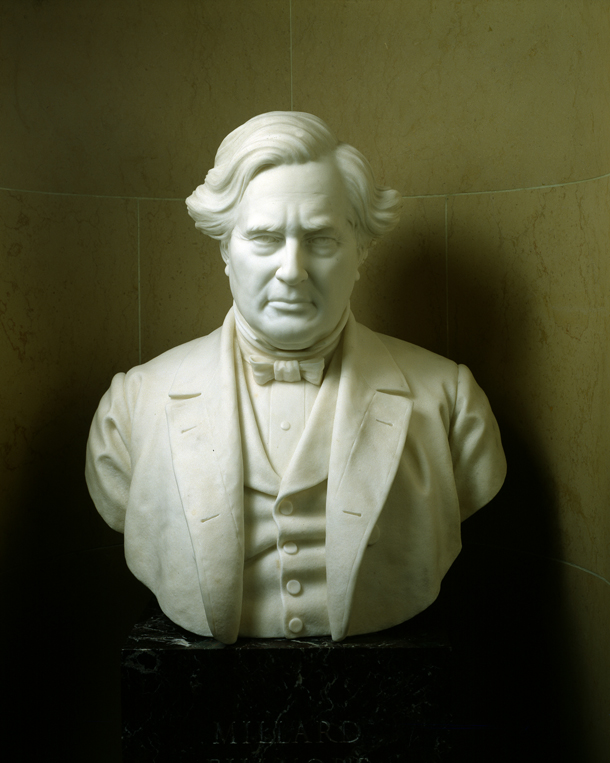
| Title | Millard Fillmore |
| Artist/Maker | Robert Cushing ( 1841 - 1896 ) |
| Date | 1895 (carved), 1894 (modeled) |
| Medium | Marble |
| Dimensions | h. 30.25 x w. 26.5 x d. 18 in. (h. 76.8 x w. 67.3 x d. 45.7 cm) |
| Credit Line | U.S. Senate Collection |
| Accession Number | 22.00012.000 |
New York sculptor Robert Cushing executed this bust of Millard Fillmore for the Senate’s Vice Presidential Bust Collection in 1895. Although little documentation on the commissioning exists, it can be assumed that the Joint Committee on the Library contacted Cushing under the auspices of the 1886 resolution authorizing the collection. Born in Ireland, Cushing studied with New York sculptors John Q.A. Ward and Randolph Rogers before establishing his own studio in New York City.
Noted in his day for his sculpture of prominent men, Cushing sculpted a bust of New York politician John Kelly that once occupied a place of honor in Tammany Hall. The artist is also known for his public statues, which included abolitionist Garrett Smith and mission priest John Drumgoole.
According to Cushing’s correspondence, preserved at the Capitol, the artist searched extensively for direct visual information to inform and guide his likeness of Millard Fillmore. Ultimately he relied on engravings dating from the former president’s lifetime and on a “scientific bust” of Fillmore borrowed from the New York firm of Fowler and Wells. This firm led the American phrenological movement, which touted the careful examination of the conformation of a person’s skull as a means of reading character traits and presumed mental capacity.
Cushing’s clay model was translated into marble in Italy and placed in the Senate Chamber in 1895.
Millard Fillmore, a successful Whig politician from New York State and a member of the U.S. House of Representatives, became the 12th vice president and 13th president of the United States. Born in Locke (now Summerhill), New York, Fillmore was assisted in his early political career by Thurlow Weed, a Whig strategist and political leader in New York. Fillmore served in the U.S. House of Representatives during the years 1833 to 1835 and 1837 to 1843. As chairman of the Committee on Ways and Means, Fillmore was active in framing the protective Tariff of 1842. He ran successfully as the Whig candidate for vice president in 1848 with Zachary Taylor. As president of the Senate, Fillmore presided over the debates on the Compromise of 1850, a series of measures introduced by Henry Clay to address slavery and territorial issues.
On July 9, 1850, President Taylor died from what his doctors diagnosed as "cholera morbus." A day later, Fillmore was sworn in as president of the United States. In his attempt to achieve legislative closure on the Compromise of 1850, Fillmore signed the Fugitive Slave Act, a part of the compromise developed by Clay. Shortly thereafter, the president approved a $100,000 appropriation for the enlargement of the Capitol, considered a necessity due to space limitations. Fillmore was responsible for selecting the manner by which the Capitol would be extended–-approving the design for large north and south wings–-and choosing the architect, Thomas U. Walter. He also laid the cornerstone for the extension on July 4, 1851.
Fillmore failed to win the Whig presidential nomination in 1852 and four years later ran as an unsuccessful presidential candidate of the American, or Know-Nothing, Party. Fillmore retired to Buffalo, New York, where he became the first president of the Buffalo Historical Society and the first chancellor of the University of Buffalo, a post he held until his death in 1874.